
In November 1777 French botanist Joseph Dombey, above, set sail for Peru and Chile, as part of the joint Spanish-French Ruiz & Pavón Expedition. The arduous eleven year botanical exploration provided a wealth of plant specimens, an international incident known as the "Dombey Affair," and two minerals previously unknown to science.
His first shipment of "botanical specimens" to France, after less than a year of collection, included "some extremely rare antiquities such as the vases found in the tombs of the ancient Peruvians and a dress of the Incas," Quite a Jack the Lad, was Dombey, for a flower-picker...
His non-botanical acquisitions were extensive, he obviously took time off from collecting Spermatophytes and grave-robbing for his mineralogical interests -


Dombey also spent his leisure time attending the sick as a physician for no fee, between womanising and gambling in Lima. His mineral samples were well received by French academics when they arrived in 1785. The pale green crystals he'd obtained in Peru, alluded to above as l'euclase, were examined by the "Father of Modern Crystallography," Abbé Haüy. He named the new mineral Euclase in 1792. Haüy had them analysed in 1798 by the discoverer of beryllium, Vauquelin.
Euclase is a Nesosilicate - beryllium aluminium hydroxide silicate BeAl(SiO4)(OH)

Unfortunately Joseph Dombey couldn't remember where in Peru he'd obtained the specimens. This isn't surprising, as he'd had a rather busy time, which this 30 page account of his life attests. However it causes difficulty in assigning a type locality for euclase.
For many years the only specimens of euclase in European mineral cabinets were Dombey's Peruvian examples. Then bluer, deeper coloured, euclase crystals began to arrive from a new find in Brazil, at Villa Rica. This from Cuvier's 1819 Dictionnaire des sciences naturelles -
"It is to the famous traveler Dombey that we owed the first crystals of euclase; he brought them from Peru but either that they had been given him or that the place of the discovery had left his memory it was impossible for him to find any information on the deposit of this precious substance. It has since been found in isolated crystals at the general mines (Minas Gerais) near Casson, Brazil, and it is from this last country that these bright blue crystals, which exist in the cabinets of MM Heuland and Rundell at London, as well as that of which the collection of M Haüy was recently enriched. The euclases of Dombey are of a very pale green of water, and this difference of hue with those of Brazil, joined to the distance of the two countries which have furnished them, we presume with some probability that euclase is found in several different localities."
The Brazilian town of Villa Rica is now known as Ouro Preto, and is the type locality given by Mindat, even though it's on the other side of the continent. It's a shame to have the type locality in a completely different country to where the mineral was first found....
At least the type locality for Dombey's other unknown mineral, Peruvian Green Sand, can be pinned down a tad better -
Pounce Pot Powder
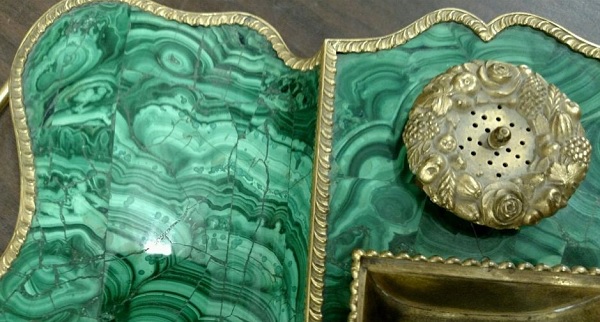
Pounce is a fine powder, used to prevent ink from spreading or bleeding into unsized paper. A "Pounce Pot" was always present as a matching accessory to the ink-pot in writing sets, quill-pen calligraphy being the only method of long-distance written communication before osmiridium nibs and László Bíró's innovation.
High quality pounce was a finely ground fragrant powder, prepared from Sandarac (the gum of the north African tree Tetraclinis articulata), mixed with powdered cuttlefish bone or pumice.
The best pounce however, was an expensive import, from the Atacama desert between Chile and Peru. Known as arsenillo or Peruvian green sand, discovered by Joseph Dombey, it was ideal for drying the ink of quill-written manuscripts.
The above Louis XVI malachite inkstand has a gilt pounce pot which, in its later years, would contain posh peruvian pounce - powdered natural copper(II) chloride hydroxide Cu2(OH)3Cl - copper minerals for copperplate script!
In 1786 Dombey's green sand of Peru came to the attention of several illustrious French achedemicians, including the Duke de La Rochefoucauld and the famous chemist Berthollet -
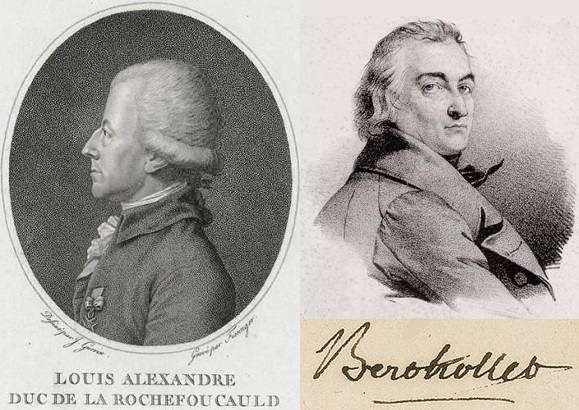
Their analyses of the new mineral were published, and the Duke's rather lengthy article contains locality info -

"M. Dombey who made a present at the Academy of Green Sand found in Peru, he commissioned us on the 26th to make an analysis of it...
...It would be important to know its natural history, but Dombey did not even buy it from an Indian at the Copiapu mines, and all he could learn from this Indian and his parish priest is that in a small river in the province of Lipes, two hundred leagues farther than Copiapu, this river is lost in the sands of the Atacama desert, which separates Peru from Chile, and this green sand is scarce."
Due to socio-political border changes (war) through the ages, Lipes province, Peru, doesn't exist anymore - but from an 1812 Geographical Dictionary, this can be gleaned -
"LIPES, a province and corregimiento of Peru; bounded north by the province of Carangas, north-east by that of Paria and that of Porco, east by Chicas, south-east and south by Tucumán. Its length is 60 leagues from north-west to south-east and its width 20 at the broadest part."
And from Bonnycastle's 1818 Spanish America we get (possibly very rough) co-ordinates of 21° 40' South 68° 16' West for the capital of the same name.
From this we can conclude that the type locality area is now within northern Chile, possibly crossing into Bolivia. Researching into that area we have this from Bollaert's 1860 Antiquarian, Ethnological, and Other Researches -

So... From Guatacondo (also now known as Huatacondo) one can look down towards where "Peruvian" green sand was originally collected, to be shipped to Europe for wealthy calligraphers. As can be seen from the zoomable map below, and the drainage basin morphology diagram following, the Guatacondo river dries up as it goes west.

above diagram from Uplift of the western Altiplano plateau. Pia Victor, 2004
From the 1817 Encyclopaedia Londinensis - "The pulverulent form of muriat of copper called green sand of Peru is found in a small river which loses itself in a desert that separates Chili from Peru. It was brought into Europe mixed with sand and other earthy particles."
As you will have gathered, the green sand is of course Atacamite, for which Mindat gives the type locality as the Atacama Region, Chile - an area of 29,000 square miles.
My attempt at locating where Dombey got his green sand is within a smaller area - close to the dried-up bed of the Guatacondo river, a few kilometers west of Huatacondo. But there's a couple of assumptions used, so caution would dictate the use of the more conservative type locality. At least it's got to be right. Or has it?
My online access to old maps of Peru has not been fruitful in terms of determining the geographical border of Lipes province, superimposed onto the modern geopolitical map. Is part of the old province of Lipes now in Bolivia? If so, then some uncertainty is introduced into the Mindat type locality area.
I'd love to hear from anyone with better historical knowledge and cartographic access and/or skills, in the comments section below, to correct any errors or to clarify what happened to Lipes province after the Pacific War. Similarly any titbits of information concerning Dombey's Green Sand of Peru would be well received.
The Naming of Atacamite

Many references attribute the naming of atacamite to Dmitri de Gallitzin in 1802. Including Mindat. This is incorrect. As far as I've been able to determine, the above German naturalist Johann Friedrich Blumenbach (1752 - 1840), described and first named it in his work Handbuch der Naturgeschichte in 1797 -
 page 660 -
page 660 -

Atacamite Structure; Pounce Porosity
Atacamite is the basic copper chloride Cu2Cl(OH)3. Basic refers to the hydroxyl ion (OH)1-, three of which combine with the copper chloride ion (Cu2Cl)3+ to form a molecule of copper(II) chloride hydroxide. Upon crystallisation, the molecular units create octahedral structures arranged in flat layers. In the crystal lattice, these sheets are arranged offset from each other, providing close atomic packing, but with perfect cleavage on {010} between the layers.
Water molecules can diffuse between the layers of atacamite's sheet-like structure. They do not bond to the lattice, so the atacamite doesn't become hydrated in a chemical sense, and the water can be driven out with heat. This absorbent property of the crystals is why atacamite was so popular with writers before the invention of blotting paper.
The minerals clinoatacamite and botallackite are polymorphs of atacamite, however although having the same chemical composition, have different crystal structures, and are of no practical use for superior penmanship.
The surface deposits of Dombey's Green Sand of Peru were worked out in the 1800s; nowadays for posh pounce, traditional calligraphers must use crushed and pulverised "ore." This 17 second video shows enough Peruvian ore to fill a Louis XVI pounce pot twice over....
Quantum Magnetism
Atacamite is being actively studied by solid state physicists. Together with a handful of other minerals, its structure shows an unusual magnetic nature -
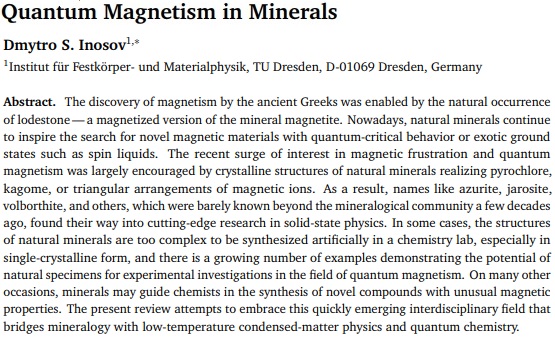
I've spent the last three weeks attempting to get a handle on quantum magnetism, so that I could explain why atacamite displays this property. Work on my phosphoroscope stalled, as did my ambulance to campervan conversion. It's a tough subject to get your head round.....
My initial quantum knowledge concerned transistor operation, which can be explained by how quantum mechanics can get cars into a workshop without opening the garage door. Through considerable further reading on the subject, I've managed to select these primers on this complex topic -
From XKCD - Why so many people have weird ideas about quantum mechanics -

And from Quantum magnets: a brief overview, Indrani Bose, 2008 -
 I don't know about you, but as introductions go it's on the heavy side......
I don't know about you, but as introductions go it's on the heavy side......
Atacamite is discussed in a some depth in Quantum Magnetism in Minerals, Dmytro S. Inosov, (page 65), although he states, "atacamite attracted considerable attention of the solid-state physics community, yet its magnetic properties are still a subject of debate."
Finding myself totally unable even to begin concisely explaining the quantum magnetism of minerals (because I just... gave up... through my totally inadequate mathematical skills & lack of mental capacity), this post now limply continues with a few atacamite anecdotes more suited to my intellect, which include knockers and swanky beer.....
Atacamite from the Pocket
The Natural History Museum, London contains three specimens of atacamite from the Hay Gill Mine in the Caldbeck Fells. They were collected in 1951 by this shifty looking gentleman -

I try not to judge a book by its cover, but I'd certainly hesitate buying a second-hand vauxhall off him. The man is Arthur Kingsbury, who was highly respected within the mineralogical community during his life (1906 - 1968).
Unfortunately many of his discoveries of rare and unusual minerals at British locations are utter bullshit. He removed foreign specimens from the many museum collections he had access to, then claimed to have found them during his field trips, had them authenticated by XRD, and published. The atacamite he found at Hay Gill mine was described by Bridges, Rumsey & Leppington -
"There are sound geochemical reasons for saying there is no possibility that a specimen as rich as this could have originated in the Caldbeck Fells and the same is true for the two lesser specimens. They are all virtually certainly fraudulent."
A report on Hay Gill Mine, Caldbeck Fells,Cumbria. Bridges, Rumsey & Leppington, 2011.
Atacamite from a warm pocket.
Worm Teeth

This is one of the four fangs of the venomous, and highly voracious predator Glycera dibranchiata. Incredibly, the fangs contain atacamite, which provides resistance to wear -
High Abrasion Resistance with Sparse Mineralization: Copper Biomineral in Worm Jaws. Lichtenegger et al, Science, 2002.
"Biominerals are widely exploited to harden or stiffen tissues in living organisms, with calcium, silicon, and iron-based minerals being most common. In notable contrast, the jaws of the marine bloodworm Glycera dibranchiata contain the copper-based biomineral atacamite [Cu2(OH)3Cl]. Polycrystalline fibers are oriented with the outer contour of the jaw. Using nanoindentation, we show that the mineral has a structural role and enhances hardness and stiffness. Despite the low degree of mineralization, bloodworm jaws exhibit an extraordinary resistance to abrasion, significantly exceeding that of vertebrate dentin and approaching that of tooth enamel."

Black Smokers

Discovered using the ALVIN submersible in the late 70s, black smokers are chimney like structures, several meters tall, spewing hot black water into the oceans. The inky black water is a suspension of heavy metal sulphides, some of which crystallise inside the silica chimney, forming deposits of chalcopyrite and sphalerite -

When a black smoker chokes out or collapses, the chalcopyrite reacts with seawater, forming seafloor atacamite deposits.
Anthropogenic Acatamite

Atacamite encrusted miner's boots, found 150 meters down in an early 1900s copper mine. A Russian mouse replaced by atacamite, with large (of suspiciously unnatural crystal form) chalcanthite crystals, displayed at the Fersman Museum in Moscow.

A 6th century mummified miner just after the discovery of his body. He is slumped on bags of acatamite he'd been mining before expiry. Found in 1899 inside the Restaradora atacamite mine near Chuquicamata, Chile, the miner's skin was assayed at 1% copper.
 The Restaradora Atacamite Mine in the Atacama Desert
The Restaradora Atacamite Mine in the Atacama Desert
Below, the green mummy being inspected by the mine owner Mr. Matthews, just after removal.
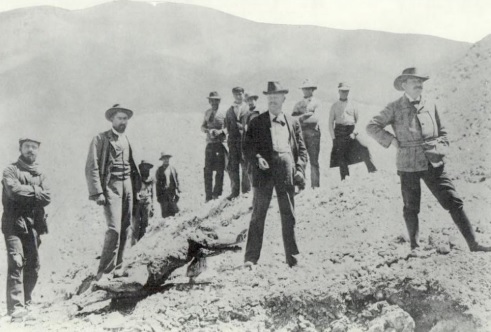 "Don't look like Pedro's got a day's work left in him boys, let's just weigh him in for the copper!"
"Don't look like Pedro's got a day's work left in him boys, let's just weigh him in for the copper!"
The mummified body of "The Copper Man," instead of being respectfully reinterred, was subject to arguments between Matthews the mine owner, and the Frenchman Pidot, who had been renting the mine. Pidot reckoned the mummy was his, as it assayed as copper ore. Matthews responded that he'd been renting the mine, not the miners!
Soon the body was being bought and sold as a curiosity, and was advertised to be shown at the Pan-American Exposition in Buffalo, New York in 1901 -
"Human Petrification: The Only Specimen in Existence of a Perfectly Preserved Body from a Race Which Is Now Entirely Extinct."

Sanctuary Knocker
In the Middle Ages, criminals or fugitives could knock on the door of Durham Cathedral using the knocker below. They'd be given a month's sanctuary, then booted out to face justice. The bronze knocker, as with most weathered bronze artifacts, has atacamite as a constituent of the green encrustations.
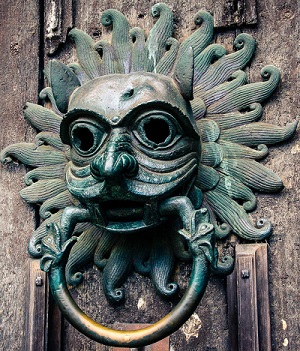
The Durham Sanctuary Knocker is the only priceless 12th Century antiquity that I've personally used to open bottles of Newcastle Brown Ale with. This was before I looked old enough to pass for 18 in Durham's fine boozers, and had to make do with outdoor revellry. Thankfully nowadays a replica is in place, protecting the real treasure from today's young hooligans.
I'm ashamed, very, very ashamed. I could blame the beer, known locally as "Dog," for any blemishing of the atacamite patina, but that would be like blaming Swanky Beer for Cornish misbehavior in the Antipodes -
Swanky Beer
Produce of the Yorke Peninsula, Australia, Swanky beer was allegedly drank by Cornish miners who had emigrated to unearth a fortune in Aussie copper.

Oswald Pryor, in his 1962 book Australia’s Little Cornwall, had this to say of the brew -
“Swanky was a brew of sugar, hops, ginger, wheat, malt, and yeast. It had to be allowed to work for three days in the bottles before the corks were tied down with string.” popular with teetotalist religious groups who “believed—or made a pretense of believing—that it was non-intoxicating.”
The Cornish had been the principle miners in the area from the 1840s, and at the Kapunda Mine, some 10s of km east of the main map above, atacamite was found in 1845. This from South Australia and its Mines, Francis Dutton, 1846 -



The best crystals of atacamite in the area (or worldwide) were found down the New Cornwall mine, near Kadina. The mine opened in 1861, with prime specimens (with crystals measured in inches) found and sold to museums in the following eight years.
Here's a beautiful specimen from the New Cornwall mine -
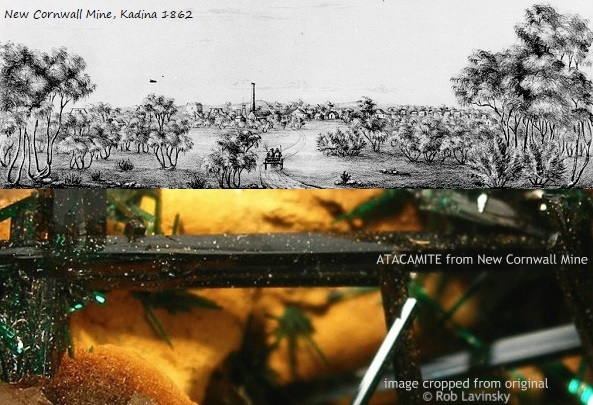
References -
Uplift of the western Altiplano plateau. Pia Victor, 2004
Atacamite from Cumberland and Cornwall, Kingsbury & Hartley, Mineralogical Magazine, 1956
The Crystal Structure of Clinoatacamite. Grice et al, 1996
The "Copper Man": A Prehistoric Miner and His Tools from Northern Chile. Junius B. Bird, 1975
Mummies - Dinosaurs in the Attic. Douglas J. Preston, 1986
Historical Account of Jos. Dombey, Deleuze, 1806
Dictionnaire des sciences naturelles, Cuvier, 1809
D'un Sable Vert Cuivreux du Peru. Rochefoucauld et al, 1786
The Geographical and Historical Dictionary of America, Alcedo, 1812
Spanish America, Bonnycastle, 1818
Antiquarian, Ethnological, and Other Researches, Bollaert, 1860
Handbuch der Naturgeschichte, Johann Friedrich Blumenbach, 1797
XKCD
Quantum magnets: a brief overview, Indrani Bose, 2008
Quantum Magnetism in Minerals, Dmytro S. Inosov, 2018
A report on Hay Gill Mine, Caldbeck Fells,Cumbria. Bridges, Rumsey & Leppington, 2011
High Abrasion Resistance with Sparse Mineralization: Copper Biomineral in Worm Jaws. Lichtenegger et al, Science, 2002
South Australia and its Mines, Francis Dutton, 1846
And Now For Something Completely Different